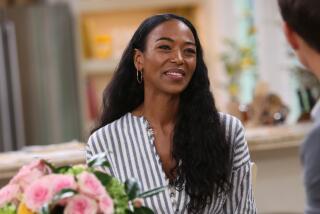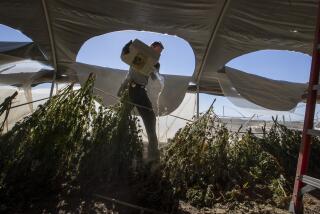The cancer drug
- Share via
Ahh, cancer. One learns so much from being diagnosed with a death-sentence disease. Of course, 95% of it is stuff you would rather not know, but that other 5% is downright interesting. For example, “America’s Next Top Model” is much more fun to watch when you’ve lost 15 pounds without trying. During chemotherapy, vanilla smells good, but vanilla wafers taste disgusting. And eyelashes really do have a purpose; without them, my eyes are a dust magnet.
But the most compelling fact I learned was about my friends. Not just what you would expect: how they cooked for my family and picked up my kids and took me to doctors and pretended not to notice how bad I looked and, most important, that I could not -- cannot -- survive without them.
No, what really shocked me was how many of my old, dear, married, parenting, job-holding friends smoke pot. I am not kidding. People I never expected dropped by to deliver joints and buds and private stash. The DEA could have set a security cam over my front door and made some serious dents in the marijuana trade. The poets and musicians were not a surprise, but lawyers? CEOs? Republicans? Across the ideological spectrum, a lot of my buddies are stoners. Who knew?
OK, I admit it, in college I smoked dope with the rest of them. I mean, everybody was doing it -- an excuse I do not allow my children -- and at parties I didn’t want to be uncool. Plus, I felt my only other option was alcohol, and the sweet drinks I liked were too fattening. But that was a long time ago, and since then I have learned to drink bourbon straight, get high on life and appreciate the advantages of not doing anything you wouldn’t want your kids to do.
I thought all my friends felt the same. Boy, was I wrong. When I surfaced from my chemo haze enough to care about anyone else, I was curious. Why do so many 40- and 50-somethings still get high? I asked my suppliers. Pain was the No. 1 answer. Not just the psychic angst of being mothers and fathers to teenagers, but real physical pain. We’re all beginning to fall apart, and for those who imbibe, a couple of tokes really take the edge off the sciatica, rotator cuff injuries, irritable bowel syndrome and migraines.
The second biggest reason was anxiety. Perhaps we can blame politics for middle-age pot use: the war, the environment, the loss of our civil liberties, little things like that.
Obviously some of us use drugs to ease the lives of quiet desperation we never thought we would have back when we were getting stoned the first time. Our drug use now is really the same as in college. Then I got high to relax, to gain confidence, to forget I was an overweight, mediocre college student terrified of the future. Now we get stoned to relax, forget our disappointing careers and mask our terror of not just our own future but the future for our kids as well. Is it so different from my dad coming home from work and having a couple of martinis? Or my mother and those little prescribed pills she took when she felt “nervous”? At least -- we can rationalize -- marijuana is all natural.
I spoke to my oncologist about the pros and cons of marijuana use for cancer patients. He said he was part of a study 25 years ago on the effects of pot on nausea, joint pain and fatigue caused by chemotherapy. It worked then, he said; it really helped some people. But now they have great new drugs, such as Emend, dexamethasone and Ativan, that keep the nausea and other pain at bay. He said the people who use pot now do it because they like it. Or maybe they use it because they would rather support a farm in Humboldt County than a huge pharmaceutical conglomerate.
After chemo No. 1, I was violently ill. Anti-nausea drugs notwithstanding, I was hugging the porcelain throne. My body did not want to be poisoned; I guess it liked cancer better. I was willing to try anything, so I lit up. It helped. A lot. I collapsed on the couch, I zoned out watching “Project Runway,” I was able to take deep breaths without puking.
My 15-year-old daughter was shocked. The look on her face was proof that her elementary school D.A.R.E. program had really done its job. A friend -- not a supplier or a user -- explained to her it was just to make me feel better and that if it worked, wouldn’t that be great? My daughter reluctantly agreed, but I knew she didn’t mean it. I had come full circle in my life -- the next time I had a toke, I stood in my bathroom with the fan on, blowing smoke out the window, but instead of my parents, I was scared my kids would find out I was smoking dope again.
The biggest pain of cancer is the gnawing, scratching, bleeding dread that they didn’t find it all, that you didn’t go to the doctor soon enough, that it is growing out of control at this very moment. My doctor recommended meditation. Yeah, right, I thought, more time sitting quietly trying not to think about dying. I had carpool for that. Meanwhile, I lost all taste for alcohol. Even half a glass of wimpy white wine could make me toss my cookies, so I turned to my friend Mary Jane occasionally, only when nothing else would do.
In the middle of one post-chemo night, my husband was out of town and I was sick and I got up and tried to get the little pipe lit and take one hit so I could maybe sleep. My son heard me struggling and he came into my bedroom. He lit the match for me and showed me where to put my finger on the “carburetor,” the hole on the side of the pipe, to make it draw. I was too grateful to ask him how he knew all this. He stayed with me until I felt better. It was mother-son bonding in a new way.
Just another reason to say: Thank you, cancer.
Diana Wagman, a professor at Cal State Long Beach, is the author of the novels “Skin Deep,” “Spontaneous” and “Bump.”
More to Read
Sign up for Essential California
The most important California stories and recommendations in your inbox every morning.
You may occasionally receive promotional content from the Los Angeles Times.










